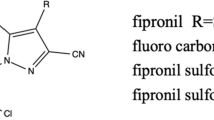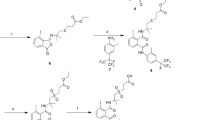Abstract
An indirect, competitive enzyme-linked immunosorbent assay (ic-ELISA) for the detection of difenoconazole was developed. Two haptens were designed and successfully synthesized. Hapten 1 had a particular moiety of difenoconazole, while hapten 2 had its full structure. The polyclonal antibodies against hapten-protein conjugates were prepared by immunizing rabbits. After optimization of the conditions, the detection limit (IC15) and sensitivity (IC50) were 4.58 and 29.10 μg L−1, respectively. The cross-reactivities of the antibody with 11 triazole fungicides were all less than 0.1%, which showed that the antibody had excellent specificity. The recoveries of difenoconazole from the spiked samples ranged from 89.70 to 102.31% with good accuracy. The matrix effect was easily removed using a simple, rapid, and efficient extraction method on fruits and vegetables. The detection limit was all 229 μg kg−1 in fruits and vegetables. To validate the ic-ELISA, samples were spiked with difenoconazole at three different concentrations and simultaneously analyzed using high-performance liquid chromatography (HPLC). The results showed a good correlation between the ic-ELISA and HPLC data (R 2 = 0.9970). As a result, the developed immunosorbent assay is suitable for the quantitative determination of difenoconazole in fruits and vegetables.




Similar content being viewed by others
References
Bertold H, Andrea D, Karl K et al (1995) Immunochemical techniques: antibody production for pesticide analysis. A review. Anal Chim Acta 311:393–405. doi:10.1016/0003-2670(95)00148-S
Du T, Cheng J, Wu M, Zhou M, Cheng M (2014) An in situ immobilized pipette tip solid phase microextraction method based on molecularly imprinted polymer monolith for the selective determination of difenoconazole in tap water and grape juice. J Chromatogr B 951:104–109. doi:10.1016/j.jchromb.2014.01.030
European Food Safety Authority (2013) Reasoned opinion on the modification of the existing MRLs for difenoconazole in various crops. EFSA J 11(3):3149. doi:10.2903/j.efsa.2013.3149
Farajzadeh MA, Mogaddam MRA, Ghorbanpour H (2014) Development of a new microextraction method based on elevated temperature dispersive liquid–liquid microextraction for determination of triazole pesticides residues in honey by gas chromatography-nitrogen phosphorus detection. J Chromatogr A 1347:8–16. doi:10.1016/j.chroma.2014.04.067
Guo C, Li J, Guo B, Wang H (2010) Determination and safety evaluation of difenoconazole residues in apples and soils. Bull Environ Contam Toxicol 85:427–431. doi:10.1007/s00128-010-0104-z
Hingmire S, Oulkar DP, Utture SC, Ahammed Shabeer TP, Baerjee K (2015) Residue analysis of fipronil and difenoconazole in okra by liquid chromatography tandem mass spectrometry and their food safety evaluation. Food Chem 176:145–151. doi:10.1016/j.foodchem.2014.12.049
Kesavachandran CN, Fareed M, Pathak MK, Bihari V, Mathur N, Srivastava AK (2009) Adverse health effects of pesticides in agrarian populations of developing countries. Rev Environ Contam Toxicol 200:33–52. doi:10.1007/978-1-4419-0028-9
Kong Z, Dong F, Xu J, Liu X, Zhang C, Li J, Li Y, Chen X, Shan W, Zheng Y (2012) Determination of difenoconazole residue in tomato during home canning by UPLC-MS/MS. Food Control 23:542–546. doi:10.1007/s00128-010-0104-z
Li J, Dong F, Cheng Y, Liu X, Xu J, Li Y, Chen X, Kong Z, Zheng Y (2012) Simultaneous enantioselective determination of triazole fungicide difenoconazole and its main chiral metabolite in vegetables and soil by normal-phase high-performance liquid chromatography. Anal Bioanal Chem 404:2017–2031. doi:10.1007/s00216-012-6240-z
Li Y, Ma X, Lu G (2013) Systematic investigation of the toxic mechanism of difenoconazole on protein by spectroscopic and molecular modeling. Pestic Biochem Physiol 105:155–160. doi:10.1016/j.pestbp.2012.12.010
Macro MP, Gee S, Hammock BD (1995a) Immunochemical techniques for environmental analysis I. Immunosensors. Trends Anal Chem 14:341–350. doi:10.1016/0165-9936(95)97062-6
Macro MP, Gee S, Hammock BD (1995b) Immunochemical techniques for environmental analysis II. Antibody production and immunoassay development. Trends Anal Chem 14:415–425. doi:10.1016/0165-9936(95)90920-I
Mu X, Pang S, Sun X, Gao J, Chen J, Chen X, Li X, Wang C (2013) Evaluation of acute and developmental effects of difenoconazole via multiple stage zebrafish assays. Environ Pollut 175:147–157. doi:10.1016/j.envpol.2012.12.029
Sandip H, Dasharath PO, Sagar CU, Shabeer TPA, Banerjee K (2015) Residue analysis of fipronil and difenoconazole in okra by liquid chromatography tandem mass spectrometry and their food safety evaluation. Food Chem 176:145–151. doi:10.1016/j.foodchem.2014.12.049
Sun J, Liu B, Zhang Y, Wang S (2009) Development of an enzyme-linked immunosorbent assay for metolcarb residue analysis and investigation of matrix effects from different agricultural products. Anal Bioanal Chem 394(8):2223–2230. doi:10.1007/s00216-009-2911-9
Thom E, Ottow JCG, Benckiser G (1997) Degradation of the fungicide difenoconazole in a silt loam soil as affected by pretreatment and organic amendment. Environ Pollut 96:409–414. doi:10.1016/S0269-7491(97)00037-7
Wang C, Wu Q, Wu C, Wang Z (2011) Application of dispersion–solidification liquid–liquid microextraction for the determination of triazole fungicides in environmental water samples by high-performance liquid chromatography. J Hazard Mater 185:71–76. doi:10.1016/j.jhazmat.2010.08.124
Wang K, Wu JX, Zhang HY (2012) Dissipation of difenoconazole in rice, paddy soil, and paddy water under field conditions. Ecotoxicol Environ Saf 86:111–115. doi:10.1016/j.ecoenv.2012.08.026
Wang ZH, Yang T, Qin DM, Gong Y, Ying J (2008) Determination and dynamics of difenoconazole residues in Chinese cabbage and soil. Chin Chem Lett 19:969–972. doi:10.1016/j.cclet.2008.04.028
Xiong JF, Wu RM, Guo P, Liu MH, Wang XB, Ji WD, Yan LY (2016) Rapid detection of difenoconazole residues in celery by surface-enhanced Raman spectroscopy. Mod Food Sci Technol 32(4):283–287. doi:10.13982/j.mfst.1673-9078.2016.4.045
Zhang ZY, Jiang WN, Jian Q (2015) Residues and dissipation kinetics of triazole fungicides difenoconazole and propiconazole in wheat and soil in Chinese fields. Food Chemistry 168:396–403. doi:10.1016/j.foodchem.2014.07.087
Author information
Authors and Affiliations
Corresponding authors
Ethics declarations
Funding
This study was funded by the National Natural Science Foundation of China (Project No. 31301462) and the Ministry of Science and International Science and Technology Cooperation Program of China (Project No. 2014DFR30350).
Conflict of Interest
Bing Liu declares that she has no conflict of interest. Jiuhui Feng declares that she has no conflict of interest. Xiao Sun declares that she has no conflict of interest. Wei Sheng declares that she has no conflict of interest. Yan Zhang declares that she has no conflict of interest. Shuo Wang declares that he has no conflict of interest.
Ethical Approval
All applicable international, national, and institutional guidelines for the care and use of laboratory animals were followed. This article does not contain any studies with human participants performed by any of the authors.
Informed Consent
Not applicable.
Rights and permissions
About this article
Cite this article
Liu, B., Feng, J., Sun, X. et al. Development of an Enzyme-Linked Immunosorbent Assay for the Detection of Difenoconazole Residues in Fruits and Vegetables. Food Anal. Methods 11, 119–127 (2018). https://doi.org/10.1007/s12161-017-0983-2
Received:
Accepted:
Published:
Issue Date:
DOI: https://doi.org/10.1007/s12161-017-0983-2




